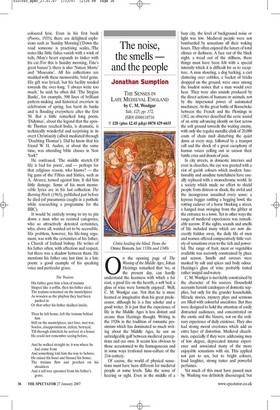The noise, the smells and the people
Jonathan Sumption THE SENSES IN LATE MEDIEVAL ENGLAND by C. M. Woolgar Yale, £25, pp. 372, ISBN 0300118716 © £20 (plus £2.45 p&p) 0870 429 6655 n the opening page of The Waning of the Middle Ages, Johan Huizinga remarked that 'we, at the present day, can hardly understand the keenness with which a fur coat, a good fire on the hearth, a soft bed, a glass of wine were formerly enjoyed'. Well, C. M. Woolgar can. Not that he is more learned or imaginative than his great predecessor, although he is a fine scholar and a good writer. It is just that the experience of life in the Middle Ages is less distant and arcane than Huizinga thought. Writing in the 1920s in the tradition of romantic pessimism which has dominated so much writing about the Middle Ages, he saw an unbridgeable gulf between medieval perceptions and our own. It seems less obvious to those accustomed to the homogeneous and in some ways irrational mass-culture of the 21st century.
Of course, the world of physical sensations must have been different for medieval people at some levels. Take the sense of hearing or sight. Even in the middle of a busy city, the level of background noise or light was low. Medieval people were not bombarded by sensations all their waking hours. They often enjoyed the luxury of total silence or darkness. A face out of the black night, a tread out of the stillness, these things must have been felt with a special intensity which it is difficult for us to recapture. A man shouting, a dog barking, a cart clattering over cobbles, a bucket of bricks dropped on the ground, were once among the loudest noises that a man would ever hear. They were also sounds produced by the direct actions of humans or animals, not by the impersonal power of automated machinery. At the great battle of Roosebeke between the French and the Flemings in 1382, an observer described the eerie sound of an army advancing silently on foot across the soft ground towards the waiting enemy, with only the regular metallic clink of 20,000 coats of chain mail disturbing the quiet dawn at every step, followed by a trumpet call and the shock of a great cacophony of human voices yelling out in unison their battle cries and shouts of pain.
In city streets, in domestic interiors and even in churches, the eye was greeted with a riot of garish colours which modern functionality and anodyne tastefulness have usually replaced with a monochrome world. In a society which made no effort to shield people from distress or shock, the awful and the incongruous assaulted every sense: a leprous beggar rattling a begging bowl, the rotting cadaver of a horse blocking a street, a hanged man swinging from the gibbet at the entrance to a town. Yet in other ways the range of medieval experiences was remarkably narrow. If the sights, sounds and smells of life included many which are now discreetly hidden away, the daily life of men and women offered comparatively little variety of sensations even to the rich and powerful. The range of fruit, meat or vegetables available was narrowly constrained by place and season. Smells and savours were masked by salt and spices and body odour. Huizinga's glass of wine probably tasted rather insipid and watery.
C. M. Woolgar is inevitably constrained by the character of his sources. Household accounts furnish catalogues of domestic supplies, but only for the grander households. Miracle stories, mystery plays and sermons are filled with colourful anecdotes. But they were designed to hold the attention of easily distracted audiences, and concentrated on the exotic and the bizarre, not on the ordinary experience of daily existence. They also had strong moral overtones which add an extra layer of distortion. Medieval churchmen, especially if they were addressing men of low degree, deprecated intense experience and associated many of the more enjoyable sensations with sin. This applied not just to sex, but to bright colours, loud laughter, strong tastes and powerful perfumes.
Yet much of this must have passed men by. Washing was definitely discouraged, but widely practised. The denunciations of preachers and playwrights do not seem to have made the least difference to sartorial fashion before the late 16th century. Much that we regard as beautiful was in fact created as an escape from medieval notions of beauty. The plain stonework and grisaille windows of the Cistercians were deliberately calculated to avoid exciting the senses. The half-wild landscapes of the remote valleys in which they were sited are ravishingly beautiful to senses educated by the 18thand 19thcentury Romantics. But to those who lived there they were `ista hon-enda loca' (those horrible places), fit only for the most austere of religious orders.
For a historian, it is not easy to describe how other people sensed things at other times. It calls for a rare feat of empathy and imagination, for which the sources offer little assistance. The real problem is that although some help can be had from archaeology, we depend on the comparative formality of written literature and records. When we read of some human experience in a medieval document, we have to remember that the very process of writing it has injected an element of self-conscious analysis which at once removes us from the spontaneous perception of joy, fear, admiration or repulsion, hope and disappointment that we are trying to recapture. And when we write about it in a book for modern readers, we increase the distance by adding our own analysis. C. M. Woolgar has written an interesting book on an impossible subject. What he has described is not so much how people felt, but how we think about how they thought about their feelings. They are very different things.















































 Previous page
Previous page